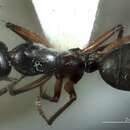en
names in breadcrumbs


Worker. HW 1.2 - 4.1; HL 1.4 - 3.4; PW 1.0 - 2.5. Head same color as mesonotum (red to black); posterior mesonotum feebly convex immediately anterior of metanotal groove (more so in minors), node broadly rounded above; tibiae and scapes lacking erect setae, propodeum with> 10 erect setae, scattered on dorsum; (generally node is higher and narrower, integument shiny in ceriseipes compared with prosseri.) Scapes relatively short in minors, SI <1.5. Major worker. Metanotum distinct, propodeal dorsum feebly convex, sometimes slightly stronger near metanotum; angle well rounded; node summit rounded, posterior surface feebly concave near summit; anterior clypeal margin broadly convex across entire width, scarcely projecting, with a weak carina; head, mesosoma, node and gaster with scattered long setae. Minor worker. Anterior propodeal region feebly concave, posterior region straight, angle distinct and widely rounded, PD / D nearly 2; node summit rounded; head, mesosoma, petiole and gaster with scattered long setae; anterior clypeal margin convex, carina distinct. (This species can be confused with prosseri; in larger minor workers of ceriseipes scape is relatively short, but this difference is minimal in smaller workers.)